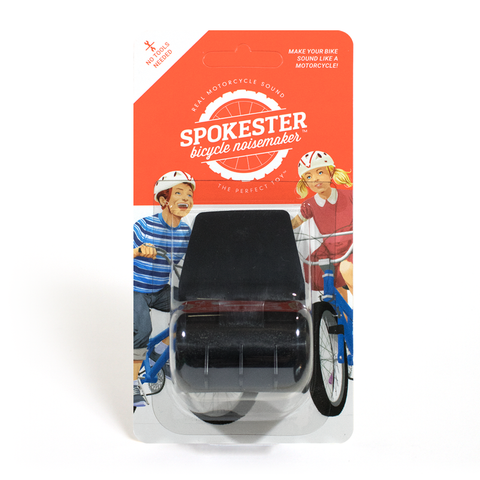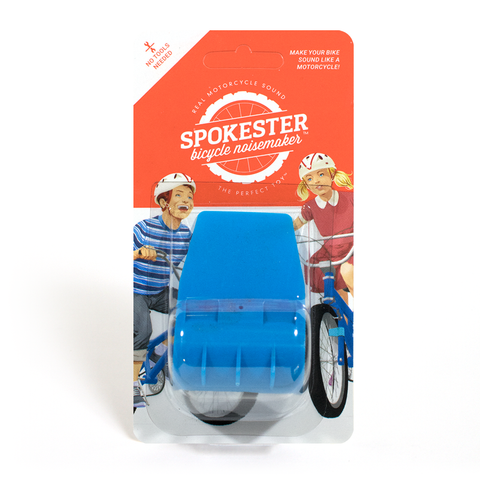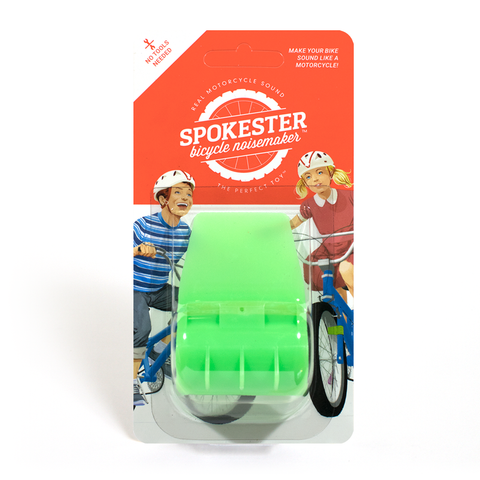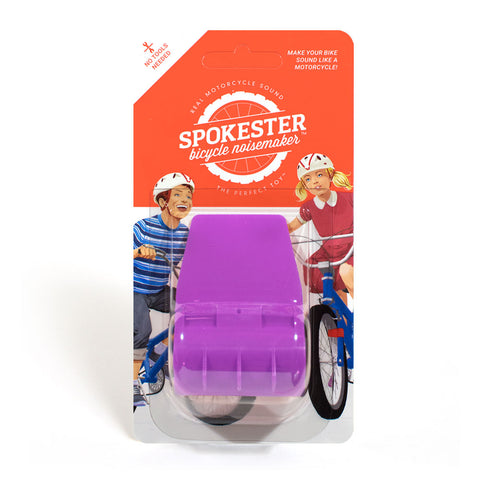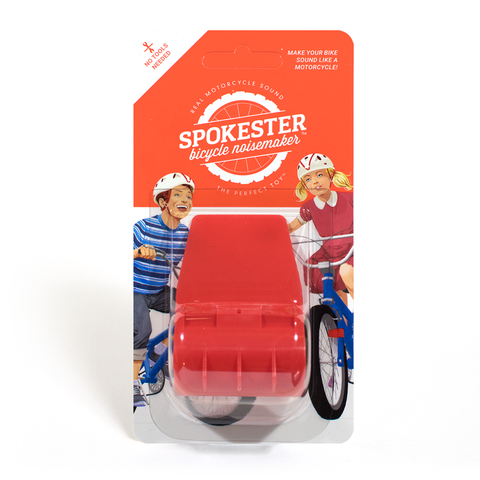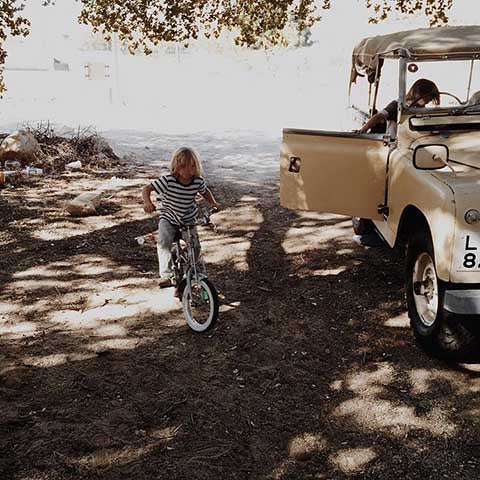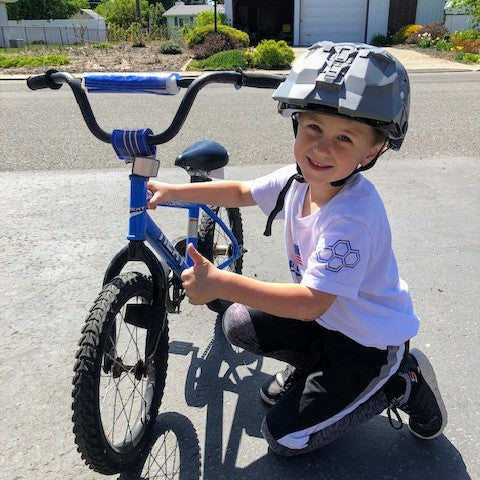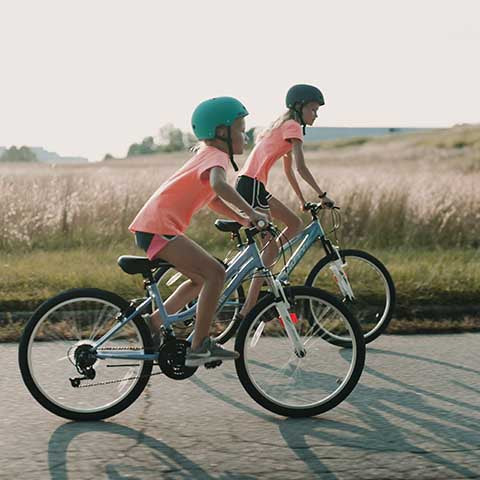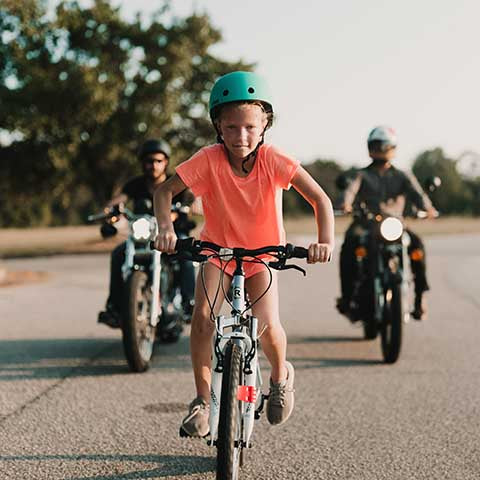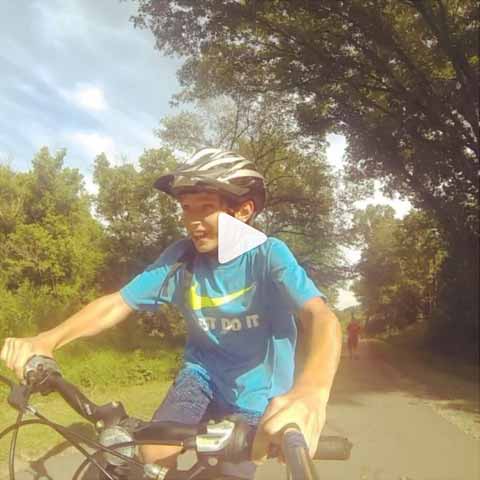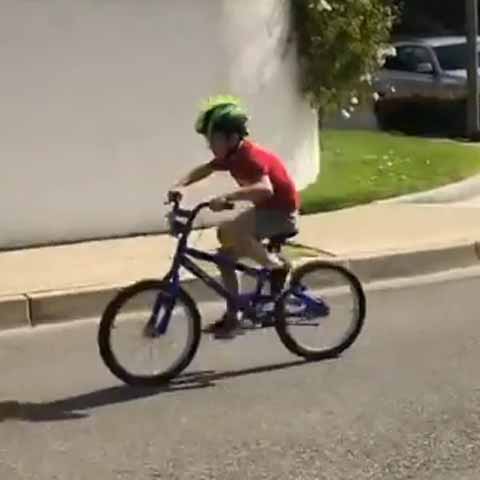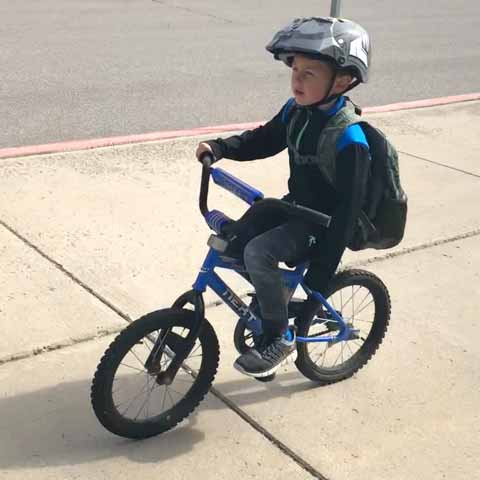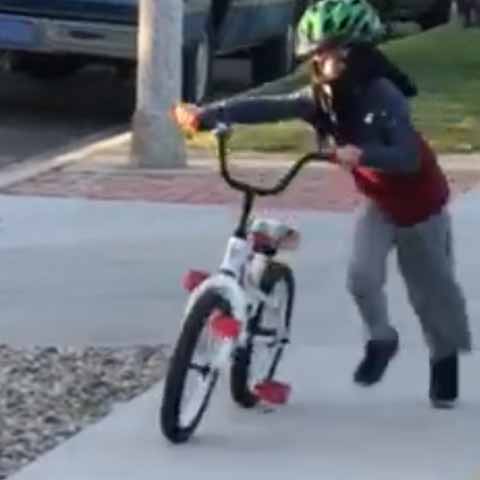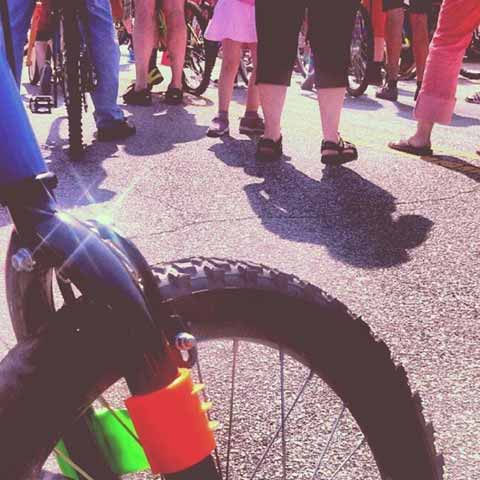Coaster Brakes or Hand Brakes – Which Should My Kid Use?
There are a lot of factors to consider when buying your child a bike but one of the most important is the bicycle's braking system.
Which brake type to use draws some divided opinions. Some parents see no problem with kids using coaster brakes (aka, foot or back-pedal brakes) when learning to ride, while others are opposed to them right from the start. Either way, there are two fundamental truths here:
- The quality of a child's bike can be measured in large part by its brakes.
- The most important thing a young rider can learn—even before pedaling—is how to stop. Braking is a big part of our ABC's of bike safety.
In this article, we'll break down the differences between coaster and hand brakes along with their pros and cons so that you can make a sound decision about what's best for your child.
Pros and Cons of Coaster Brakes vs Hand Brakes
Coaster brakes
What are coaster brakes?
The coaster brake was introduced at the tail end of the 19th Century to do a couple things. On the one hand, it allows a bike to move forward without forcing the pedals to turn. In other words, you're able to "coast" along while sitting still. Additionally, its location on the inside of the rear hub allows it to act as a brake when the pedals rotate backwards. The harder you pedal backwards, the more braking power you generate. This power takes the form of friction between the rotating and stationary parts of the wheel, slowing down and eventually stopping the bike.
The Consumer Product Safety Commission requires that bikes with seat heights under 25" be fitted with coaster brakes (although bikes with seats under 22" don't need coasters as long as they meet certain criteria). As a result, these foot brakes are standard on smaller kids' bikes, or those with wheels typically between 12" and 16" in diameter. Above this, brake systems begin to diversify since most kids move onto hand-based versions fairly quickly. Coasters are also more common on cruiser bikes than most other styles that require the ability to back-pedal.
Coaster brake benefits
Intuitive
Coaster brakes are relatively easy to learn. Pedal forward, you go. Pedal backward, you stop. In fact, constantly referring to them as back-pedal or foot brakes while teaching your child is a good way to drive this idea home. Hand brakes require a bit more skill to operate. This isn't a bad thing, it just means you need to be in tune with your child's progress when it comes to hand-eye coordination.
Fewer parts
Hand brakes require an array of cables running along the frame of the bike. Coasters don't. This simplifies the bike, and it's especially nice for anyone using folding or take-apart models. Many people also like the cleaner appearance of a no-cable bike. Aesthetics should of course come second to safety, but if that's what it takes to help get your rugrats out on the sidewalk (and out of your hair), then go for it.
Less expensive
On the whole, bikes with coaster brakes are cheaper than their hand-brake counterparts, both up front and over time. The internal nature of the braking system and its minimal components lead to coasters requiring little maintenance, if any. Keep this in mind if cost is an issue, particularly if your kid is zipping up the motor-skills chart.
All-weather performance
Being positioned within the rear hub means coasters are less susceptible to wet conditions. That doesn't mean your child won't slip and slide on damp ground, it just means it won't be because of the brakes. This is a good thing, especially for all the kids out there who can't wait to peel out of the garage seconds after the storm passes.
Good for the young and disabled
Kids grow at different speeds. Some are well on their way to handshake-crushing grips in no time, whereas others take a little longer to get there. Coasters are good choices for younglings who struggle to either reach hand brakes or activate them fully. That said, they're not age-specific. A foot brake is a reliable alternative for riders with arm or hand disabilities, amputees, and others who lack the coordination and dexterity to properly use hand brakes.
Coaster brake issues
Back-pedal tendencies
How often do you pedal in reverse without even thinking about it? Well, they do, too. Back-pedaling is a natural movement in certain situations like riding uphill or trying to maintain balance. On bikes with a coaster setup, this obviously engages the brakes. The resulting experience can be frustrating, possibly lead to falls, and even delay pedal-skills development.
Awkward foot positioning
Typical "launch" position for the crank arm (the bar connecting the pedals to the gears) places the pedals roughly between the 2 and 4 o'clock and 8 and 10 o'clock locations on either side for optimum leverage. Coaster brakes don't allow you to easily get to this position from a stand-still. Since you can't pedal backwards, you have to push the pedals into position as you roll forward. That same launch-position leverage is also ideal for braking with coasters. But, this requires your children to anticipate stopping and properly position their feet ahead of time, which isn't always possible when the dog darts out of the bushes directly in front of them.
Size difficulties
Foot brakes are generally heavier than their hand-based counterparts. While that difference may seem negligible to fully-grown riders, the weight of the child's bike is much closer to the weight of the child than yours is to you. So, every pound can matter when it comes to tinier kids and toddlers. Plus, smaller bikes have smaller crank arms, which reduce leverage and braking power. This creates potential problems for the weak-legged, especially if the bike is already half as heavy as the child.
Unserviceable
Although coaster brakes require very little maintenance, once they do need to be looked at, you may as well get a brand-new ride. As the brakes are broken in, they develop what's called "dead space." Gradually, more back-pedal power is needed to engage the foot brake. Repairing the worn-down internal components can cost as much or more than a full-on wheel or bike replacement.
Unfit for specialty bikes
Coaster brakes are fine for the boardwalk, but they can be downright dangerous for the backwoods. Mountain bikes, among other specialized styles, simply can't use coasters. For one, coasters inherently require your feet to be on the pedals at all times, but this doesn't help if you need to take them off to stabilize yourself going over bumpy terrain. Avoiding rocks, trees, and other hazards may involve back-pedaling, which is clearly a no-go with back-pedal brakes. While this isn't as big of a deal when your youngsters are first starting out, shifting to hand brakes is inevitable as they get more serious about MTBing, BMXing, and road racing.
No backup brake
If your child's bike chain suddenly breaks or slips, we've got ourselves a situation. Unlike bikes with hand brakes on each side of the handlebar or bikes with both hand brakes and coaster brakes, coaster-only bikes have no plan B. Junior may have no problem Flinstoning his way to a stop on flat ground with plenty of runway, but it's a different story if he's flying downhill or rolling through streets with occasional traffic.
Hand brakes
What are hand brakes?
Bikes without a foot-based braking setup use what's called a freewheel hub. Similar in function to coaster brakes, a freewheel hub allows the wheel to turn even if the pedals do not. However, unlike with coasters, pedaling backward doesn't stop the bike.
With a freewheel system, stopping is controlled by the hands, not the feet. Most bikes have two levers on either side of the handlebars. The left brake controls the front wheel, and the right brake controls the rear one. Activating the brakes tightens a small cable running from each brake to each wheel, causing two sets of pads to slow them down. Traditionally, these pads have been applied to the wheel's rim. These days, some bikes are using specialized discs on the hub instead. We go more into rim brakes vs. disc brakes here, but for now we'll just focus on hand brakes as a general category.
Hand brake benefits
More flexible positioning
To start from a resting position or to engage the brakes, certain pedal positions are better than others (as discussed above). With coaster brakes, you're basically subject to the position where you last stopped pedaling, and this isn't always ideal for your next move. A freewheel system with hand brakes takes this problem out of the equation. Pedaling backwards as necessary while riding also helps beginners regain their balance more easily.
Better control
Hand brakes offer more control over modulation, or braking power. Whereas coaster brakes are essentially on or off with very little wiggle room in between, hand brakes allow you to be more precise with the pressure. Being able to control braking force on downhill or slippery surfaces is pretty important. Furthermore, coasters are rear-wheel-only devices. Using handbrakes to slow both wheels stops the bike faster. Plus, because weight shifts onto the front wheel when coming to a halt, the front brake actually provides more stopping power.
Replaceable
Although coaster brakes require almost no maintenance, when they go, they go. Hand brakes, however, can be serviced when the pads eventually wear down. If all's well with the bike otherwise and it's not time to size up just yet, a quick stop at the local shop for a tune-up will do just fine.
Higher quality
While it's not true that every coaster-brake bike is a low-end bike, they do tend to sit toward the bottom of the price scale. A big reason why is the wheels. Traditional hand brakes squeeze the rim, which means the wheel itself needs to be of high quality. If it's not, it can bend more easily and end up rubbing the brake pads and reducing its overall integrity. Foot brakes don't require wheels to spin "true" (i.e., without a wobble), and therefore wheels on coaster models tend to be lower in quality.
Shortened learning curve
Odds are very, very high that your kids will eventually ditch the coasters for good. Starting them out with hand brakes from the get-go—for instance, on a balance bike—eliminates the need to re-learn how to brake once they've gotten used to back-pedaling to stop. If you're an active family that wants the little ones to get out on the single track with everyone else as soon as possible, this gets them there more quickly.
Hand brake issues
Requires strength and coordination
For youngsters just starting out, stopping requires a bit more skill and thinking if they're braking by hand. On top of this, most of these brakes have just been plain hard to use for kids with smaller and weaker hands. This has changed in recent years, though, and more children's models are coming with youth-specific handles that are easier to reach and operate.
Potential for injury
The most important thing to teach anyone, young or old, when they're learning how to use hand brakes is to never use just the left brake. Even at seemingly-mild speeds, locking only the front wheel can lead to the rider accidentally flying over the handlebars from the forward momentum. Intentionally pulling an "endo" is best left for more experienced daredevils.
Impacted by weather
Most hand brakes work because of the friction created between the brake pad and wheel rim. When these things are wet, they're not as effective. However, disc-style hand brakes are becoming more prevalent and work fine in wet conditions.
More expensive
Unfortunately, smaller bicycles don't always come with quality hand brakes. Finding a kids' bike with well-designed brakes may require a bit of a search, and when you do find one, it's likely to cost you more than the other models. Plus, hand brakes require maintenance over time, which could lead to additional out-of-pocket expenses at the bike doctor if you're not a do-it-yourselfer in this department.
What bike brakes should I get on my kid's bike?
The vast majority of people will switch to hand brakes at some point (and if you happen to be at that point, here are seven ways to teach your kids how to use them). But, that doesn't mean they're the best choice for every child. Consider the following rules as a starting point for any parent.
Coaster (foot) brakes for your kid IF he/she:
- Is developing coordination skills slowly and/or has small or weak hands
- Used coasters with a training-wheel bike and you want him/her to get used to no trainers before learning new brakes
- Has a disability that makes hand brakes difficult or impossible
Hand brakes for your kid IF he/she:
- Shows strong coordination skills early and has enough hand strength and dexterity
- Used hand brakes with a balance bike and is competent enough with them on his/her first pedal bike
- Will likely advance to specialized models more quickly than most (for instance, to mountain bike with the family at an early age)
Whichever you decide, make sure your kids prove they know how to stop safely before they take to the streets. Happy braking!
← Older post Newer post →
